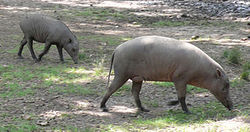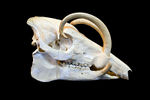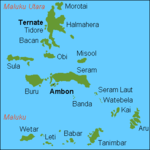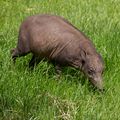Babirusa
| Babirusa |
|---|
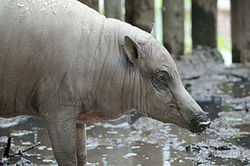
|
| Scientific Classification |
|
| Species |
|
| A mother and baby babirusa forage for food |
The Babirusa is a member of the pig family. It has been put on the almost endangered species list. Its main threats are larger scale commercial logging and shifting cultivation. This animal resembles a deer in its habits, and may be closer to being a hippo than a pig. There are four species of Babirusa that live around and in the islands of Indonesia. They get their names from the islands that they are found on.[2]
Body Design
The Babirusa, a pig-like mammal which has four different species. They are well known for their curving tusks and as well as having multiple pairs of tusks. The curving tusks are only found in males and the females lack canines entirely. This animal is a very curious one; throughout their life their growth, anatomy, and functions are all odd. Their lower canine grows in the correct anatomical position, but it becomes particularity long and overlaps the outside edge as it grows. The upper canine also grows downwards and spirals until it is parallel to the lower canine. Spiraling canines are not present in all babirusas Regardless in babirusas with spiraling tusk, if they live long enough, the canines can grow into the head and eventually kill the babirusa.[3]
Life Cycle
As an infant the Babirusa resembles a pig, but it is smaller and darker. Their first meal is their mothers milk, which provides them with antibodies and nutrition. Also, they start to grow their horns in this stage of life. At around 15 years of age the babirusa has grown its horns. It will now find a mate. After the mating process the female becomes pregnant for about 153 days and then it gives birth. Then the life cycle of this amazing animal starts all over again! [4]
Ecology
The Babirusa live in the swamps and forests of the Indonesian islands. They are native to the islands of Sulawesi, Togian, Sula, and Buru.[5] They have been found to be, like most pigs, omnivorous. This species eat mostly leaves, but have been found to have eaten invertebrates. They are very good at eating bipedally(without support) and every once and a while they will eat the juveniles of other babirusas. They also dig and burrow for food in the ground.[3] although not much is known about the Babirusa it is known that they are found to live on the banks of rivers and ponds in the rainforests of Indonesia. They usually stay in groups of about five. The Babirusa does not exhibit the rooting ability, but it does probe wet sand as well as muddy soil for food. [6]
Disputed Classification
While the Babirusa is considered a member of the pig family, it is now being found that it is closer to being a hippo than a pig. They are also closely related to the deer. This species is nearly endangered. The Babirusa can reach up to 3 feet in length and the tail is 10 and 1/2 inches long. The lower tusks are for digging and fighting while the upper tusks of the animal are used as shields for the eyes. Their tusks also grow continually. The babirusa is the fastest animal in the family of pigs and it can run as fast as deer. Unlike males, the females tusks are normal size or completely absent. The Babirusa communicates via grunts. They are also excellent swimmers and can swim from island to island in search for food. [7]
Video
A video of the babirusa and the helpful guide is telling us all about the animal.
Gallery
References
- ↑ Babyrousa wikispecies. Web. last modified December 3, 2017. author unknown
- ↑ author unknown. Babyrousa babyrussa iucn red list. Web. accessed April 29, 2018.
- ↑ 3.0 3.1 Naish, Darren. What’s with the bizarre curving tusks? Babirusas, part III science blogs.com. Web. posted February 17, 2010.
- ↑ author unknown. The life cycle of a babirusa sway.com. Web. accessed April 29, 2018.
- ↑ bates, mary. the creature feature: 10 fun facts about the babirusa wired. Web. published may 19, 2014.
- ↑ author unknown. Babyrousa babyrussa iucn red list. Web. downloaded April 30, 2017.
- ↑ Babirusa facts softschools.com. Web. accessed April 29, 2018. author unknown
